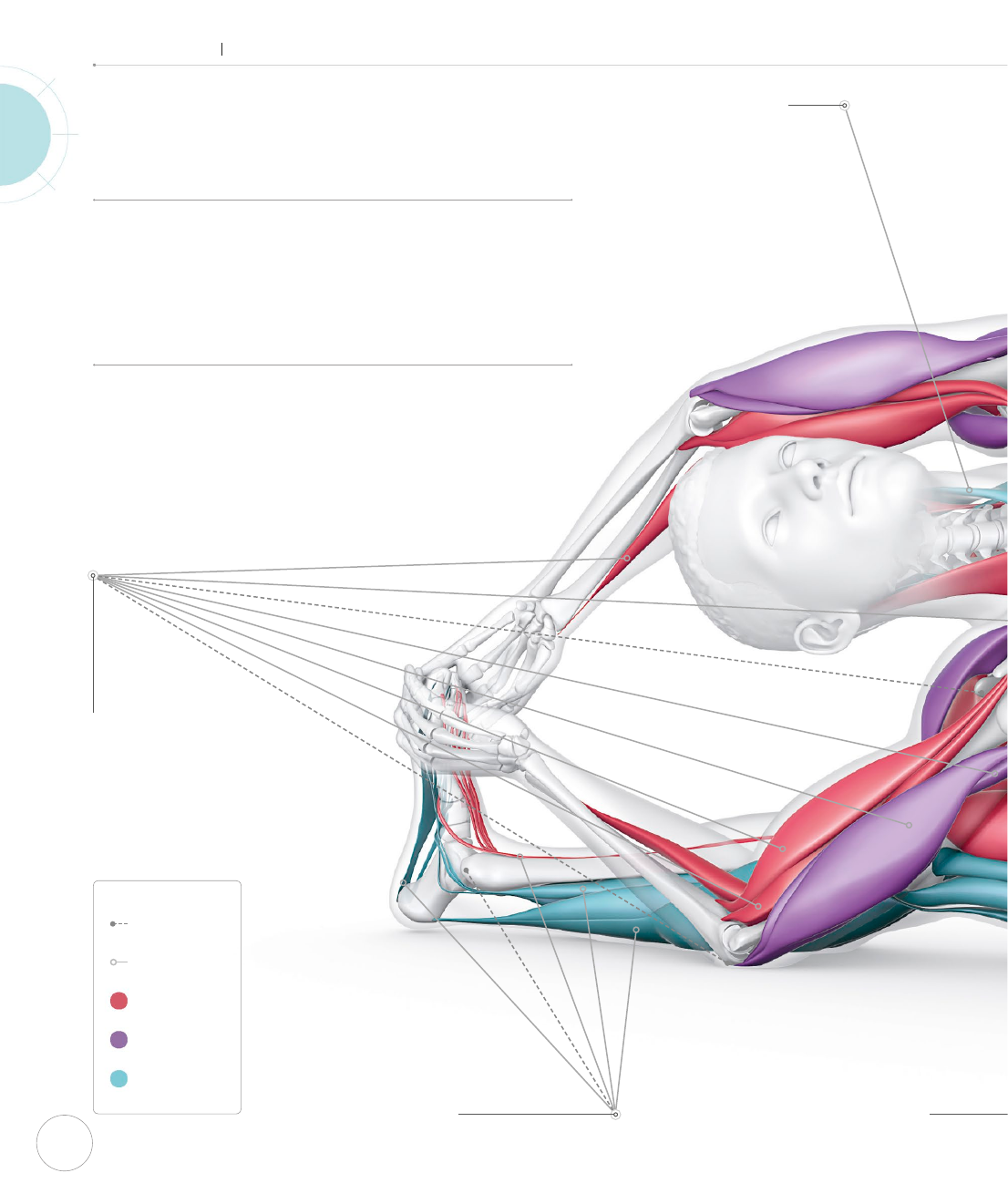
64
THE ASANAS
Seated
This seated, lateral side stretch allows you to
mobilize your spine in a way that you probably don’t
often move it in everyday life. The novel movement that
this pose involves benets your intervertebral discs,
nervous system, and fascia.
THE BIG PICTURE
As you bend deeply to the side, muscles along your spine
stretch and strengthen. Your shoulder muscles engage to
reach your arms over your head, and your thigh muscles
on both sides stretch in dierent ways.
SIDE BEND
Parivrtta Janu Sirsasana
Neck
To rotate your neck, your
rotatores, multidus,
sternocleidomastoid, and
semispinalis cervicis engage
on the side toward the ground
(model’s right in this image),
while stretching on the
upward-facing side. Your
splenius capitis and splenius
cervicis engage on the
upward-facing side (model’s left
in this image), while stretching
on the downward-facing side.
Arms
Your shoulder exors—including
the anterior deltoids—engage. Your
middle deltoids and supraspinatus
engage to abduct your shoulders, and they
are externally rotated by your posterior
deltoids, infraspinatus, and teres minor
muscles. Your brachialis, biceps, and
brachioradialis muscles ex your elbows.
Thigh
Your hamstrings and gluteus
maximus stretch, while your
quadriceps engage to extend your
knee. Also, your internal rotators—
including gluteus medius, gluteus
minimus, and tensor fasciae latae—
engage while lengthening. You may
feel a stretch in your iliotibial band.
Extended lower leg
Your ankle dorsiexors
engage to dorsiex your ankle
and extend your toes. If you
are grabbing your foot and
pulling, you are probably
feeling a stretch in your calf
muscles, along with your
plantar muscles and fascia.
KEY
Joints
Muscles
Engaging
Engaging while
stretching
Stretching
Deltoids
Serratus anterior
Triceps brachii
Brachialis
Biceps brachii
Brachioradialis
Tibialis anterior
Flexor d. longus
Gastrocnemius
Plantar fascia
Sternocleidomastoid
Shoulder
Elbow
Ankle
US_064-065_Seated_side_bend_01.indd 64 20/09/2018 20:46

65
ALIGNMENT
Avoid rounding forward by reaching your top
shoulder blade back, as if you are trying to press
toward an imaginary wall. Focus on finding length
in your spine and broadness in your chest.
Spine
elongating
Turn head
comfortably
Knees soft,
not locked
Chest broad
Bring shoulder
blade back
Flexed leg
Your adductors, quadriceps, and
iliopsoas stretch. Although your
hamstrings engage initially to ex
your knee in place, try to relax your
leg muscles while holding the pose.
Torso
On the side toward the ground
your external abdominal
obliques, erector spinae, and
quadratus lumborum engage
while the upper side stretches,
to laterally ex your spine. On
both sides, your rotatores and
multidus rotate your spine and
send signals to your brain about
where your spine is in space.
Your transversus abdominis
engages to stabilize your spine.
Spinal extensors
External obliques
Vastus medialis
Sartorius
Adductor magnus
Psoas major
Rectus femoris
Vastus lateralis
Knee
Gluteus maximus
Pectineus
Rectus femoris
Semitendinosus
Adductor magnus
Iliopsoas
Spine
US_064-065_Seated_side_bend_01.indd 65 20/09/2018 20:46

66
SIDE BEND
Parivrtta Janu Sirsasana
Disk pushes
to opposite
side of bend
Vertebra
Disk health
When side-bending (lateral
exion of the spine), your
intervertebral disks push to
the sides. As you bend to the
right, your disks shift to the left
(and vice versa). The cartilage in
your spine allows for this
natural process.
Unilateral movement
Your quadratus lumborum (QL) is important
for holding posture. When the erector spinae
are weak it picks up the slack. Keeping your
spine erect is a big job for this little muscle,
leading to muscle fatigue and even pain. This
pose helps by stretching and engaging the QL.
CLOSER LOOK
Seated side bend is a one-sided movement
that dynamically aects your abdominals,
back muscles, and spinal disks. You don’t
have to be able to reach your foot with
either hand to do this pose; your arms
can simply reach to the side.
Abdominal structure
Your criss-crossing abdominal
muscles provide multilayered
support for your internal organs
and allow your torso to move.
Legend has it that in 1888, Dr.
Dunlop, a surgeon, was watching
his son bouncing on his tricycle
due to the poor design of the
wheels, causing a headache.
Inspired by the structure of the
abdominals, he designed a tire for
a smoother ride and fewer ats.
Quadratus
lumborum
engages on
lower side
Quadratus
lumborum stretches
on upper side
External
oblique
Transversus
abdominis
Internal
oblique
Rectus
abdominis
Latissimus dorsi
stretches on the
upper side
US_066-067_Seated_side_bend_02.indd 66 02/11/2018 14:02

67
THE ASANAS
Seated
Pressure and balance
Notice and feel the point of
contact of your body on the oor
in this pose. It is a little dierent
for everybody. Notice how the
pressure points shift as you
transition in and out of the pose.
If hands don’t
reach foot, place
one hand on your
shin and reach the
other out and over
toward it
Erector spinae
engage on the
lower side
Elbow flexors
engage
POSTERIOR VIEW
Posterior deltoid
stretches and engages
to help externally
rotate shoulder
Ankle dorsiflexors
engage to flex
your ankle
Erector spinae stretch
on the upper side
Knee may be
lifted or touching
the floor
Weight is back
on buttocks
US_066-067_Seated_side_bend_02.indd 67 02/11/2018 14:02
..................Content has been hidden....................
You can't read the all page of ebook, please click here login for view all page.
